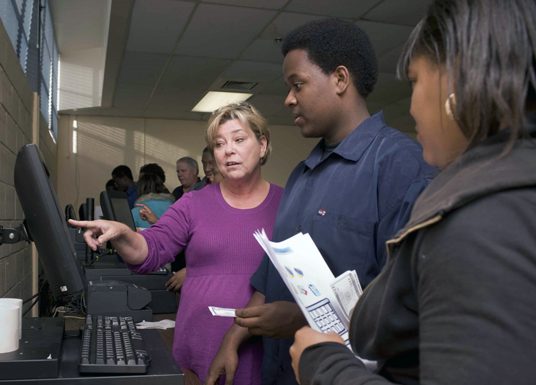Goodwill sponsors new online resource

In this period of high unemployment, not everyone has suffered equally. Two populations of particular concern are veterans and youth. Goodwill Industries of the Southern Piedmont provides services to both of these populations and is a lifeline for some of the most vulnerable populations in the Charlotte region. The agency is continuing its innovation and outreach efforts in a partnership with the UNC Charlotte Urban Institute by providing new resources to the community to understand who needs help now, and who may be at most risk in the future.
|
Understanding that the workforce development sector has changed with the recent recession and new technological innovations, Goodwill commissioned a literature review of the sector’s needs across its 18-county region. The report revealed major themes surrounding system needs, target populations and most valuable skills training. Learn about this recently released report here. |
Example: Veterans
Services for returning veterans have become an important policy issue across the country as military personnel return home from active duty service. Mecklenburg County is home to nearly 54,352 recent and aging veterans, which accounts for 8 percent of the working age population. A clear understanding of the make-up of this unique population aids in the delivery of appropriate services to assist them. The data available through the new Goodwill regional indicators partner page is a step to provide this understanding, not only for veterans but other vulnerable populations in Mecklenburg County.
In 2010, just 9 percent of the veteran population in Mecklenburg County was between 18 and 34 years old, but this proportion is expected to grow in coming years as service members return from duty in Iraq and Afghanistan. Looking over the past five years, we can see that the demographic composition of these young veterans has  changed. In 2005, 46 percent of veterans 18 to 34 years old were African-American, and 52 percent were white. By 2010, the distribution had changed to 42 percent African-American and just 42 percent white. Other population groupings (Asian, Hispanic or Latino, etc.) are not included in this analysis, which constitutes the remaining population not represented by African Americans or whites. According to the 2010 American Community Survey, the overall population that is 18 to 34 years old is 31 percent African-American, while the white population in that age group comprises 56 percent. In both years, African-Americans are represented by a disproportionate share of their overall 18- to 34-year-old population. The white population share of veterans in this age group is declining relative to their overall 18 to 34 age distribution. Older age groups are represented by a more even racial distribution of veterans relative to the overall population distributions but it appears African-Americans are increasingly a larger portion of younger veterans in Mecklenburg County.
changed. In 2005, 46 percent of veterans 18 to 34 years old were African-American, and 52 percent were white. By 2010, the distribution had changed to 42 percent African-American and just 42 percent white. Other population groupings (Asian, Hispanic or Latino, etc.) are not included in this analysis, which constitutes the remaining population not represented by African Americans or whites. According to the 2010 American Community Survey, the overall population that is 18 to 34 years old is 31 percent African-American, while the white population in that age group comprises 56 percent. In both years, African-Americans are represented by a disproportionate share of their overall 18- to 34-year-old population. The white population share of veterans in this age group is declining relative to their overall 18 to 34 age distribution. Older age groups are represented by a more even racial distribution of veterans relative to the overall population distributions but it appears African-Americans are increasingly a larger portion of younger veterans in Mecklenburg County.
|
Data available in |
Tools for understanding
This is just one example of the data available on the new Goodwill Regional Indicators partner page. For over a year, the institute has worked in partnership with Goodwill to track and analyze various social and economic measures of in-need and vulnerable populations in Mecklenburg County. Also, in conjunction with a youth needs assessment the institute completed for Goodwill, a variety of youth-related data is highlighted.
The resulting online resource lets users explore data across a range of indicators in Mecklenburg County. You can find standard measures such as poverty, unemployment and educational attainment broken down by race and age. However, you will also see unique measures not featured on the main Regional Indicators website or other Indicator Partners’ sites, such as occupational employment, various measures of youth disparities and veteran status.
In addition to the interactive data charts, you can find a variety of reports that the institute has completed for Goodwill. These reports detail the needs of youths and young adults, available workforce programs and the service needs of vulnerable populations.